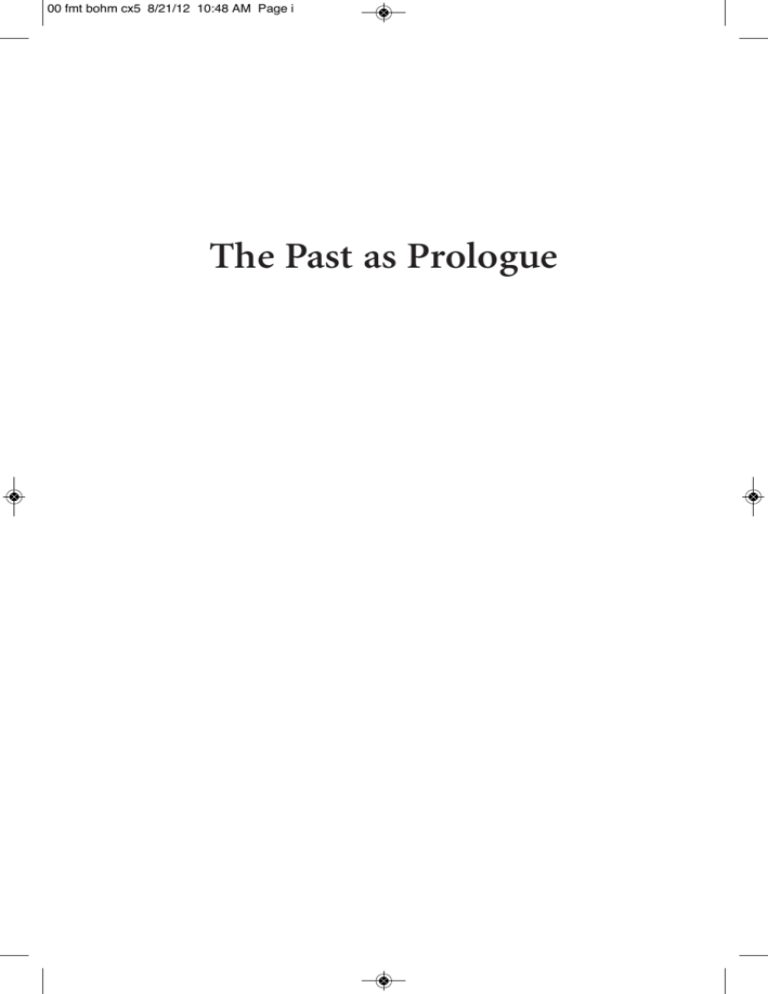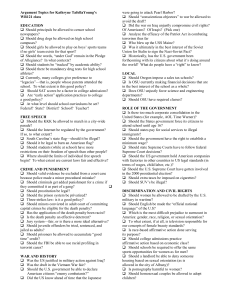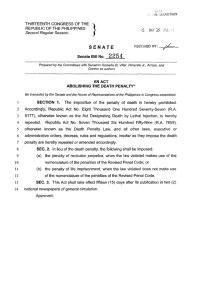
00 fmt bohm cx5 8/21/12 10:48 AM Page i
The Past as Prologue
00 fmt bohm cx5 8/21/12 10:48 AM Page ii
00 fmt bohm cx5 8/21/12 10:48 AM Page iii
The Past as Prologue
The Supreme Court’s
Pre-Modern Death Penalty Jurisprudence
and Its Influence on the Supreme Court’s
Modern Death Penalty Decisions
Robert M. Bohm
Professor of Criminal Justice
University of Central Florida
Orlando, Florida
Carolina Academic Press
Durham, North Carolina
00 fmt bohm cx5 8/21/12 10:48 AM Page iv
Copyright © 2012
Robert M. Bohm
All Rights Reserved
Library of Congress Cataloging-in-Publication Data
Bohm, Robert M.
The past as prologue : the Supreme Court's pre-modern death penalty jurisprudence and its influence on the Supreme Court's modern death penalty
decisions / Robert M. Bohm.
p. cm.
Includes bibliographical references and index.
ISBN 978-1-61163-091-6 (alk. paper)
1. Capital punishment--United States--Cases. 2. United States. Supreme
Court--History. I. Title.
KF9227.C2B64 2012
345.73'0773--dc23
2012004811
Carolina Academic Press
700 Kent Street
Durham, North Carolina 27701
Telephone (919) 489-7486
Fax (919) 493-5668
www.cap-press.com
Printed in the United States of America
00 fmt bohm cx5 8/21/12 10:48 AM Page v
Contents
Introduction
Courts Say What the Law Is: The Power of Judicial Review
The Court’s Reticence and Duty to Review State Death Sentences
Methodology
ix
x
xiii
xv
Chapter 1 • Clemency: The “Fail Safe” in Our Criminal Justice System
1. United States v. Wilson (1833)
2. Ex parte Wells (1855)
3. Biddle v. Perovich (1927)
4. Solesbee v. Balkcom (1950)
Summary
3
4
5
8
8
11
Chapter 2 • Coerced Confessions and Compelled Self-Incrimination:
Revolting to the Sense of Justice
1. Brown v. Mississippi (1936)
2. Malinski v. New York (1945)
3. Watts v. Indiana (1949)
4. Stein v. New York (1953)
5. Fikes v. Alabama (1957)
6. Griffin v. California (1965)
7. Chapman v. California (1967)
Summary
15
16
17
21
25
29
31
35
56
Chapter 3 • Cruel and Unusual Punishment: Must Draw Its Meaning
from the Evolving Standards of Decency That Mark the
Progress of a Maturing Society
1. Wilkerson v. Utah (1878)
2. In re Kemmler (1890)
3. McElvaine v. Brush (1891)
4. Louisiana ex rel. Francis v. Resweber (1947)
Summary
61
63
67
69
70
77
v
00 fmt bohm cx5 8/21/12 10:48 AM Page vi
vi
CONTENTS
Chapter 4 • Defective Lineup Procedures: A Lineup,
Conducted without Notice to Defendant’s Counsel,
Is Unconstitutional
1. Gilbert v. California (1967)
Summary
81
81
84
Chapter 5 • Double Jeopardy: Not Implicit in the Concept of
Ordered Liberty
1. Stroud v. U.S. (1919).
2. Palko v. Connecticut (1937)
Summary
87
87
92
97
Chapter 6 • Effective Assistance of Counsel: Death Is Different
1. Powell v. Alabama (1932)
Summary
99
100
110
Chapter 7 • Equal Protection: An Exceptional Punishment for
Life Prisoners
1. Finley v. California (1911)
Summary
111
111
112
Chapter 8 • Ex Post Facto: A Government of Laws and Not of Men
1. In re Medley (1890)
2. Rooney v. North Dakota (1905)
3. Malloy v. South Carolina (1915)
Summary
113
113
116
116
118
Chapter 9 • Fair Trials: Must Be Free from a Coercive or
Intimidating Atmosphere
1. Frank v. Mangum (1915)
2. Moore v. Dempsey (1923)
3. Alcorta v. Texas (1957)
4. Ciucci v. Illinois (1958)
Summary
121
121
124
128
131
132
Chapter 10 • Jurisdiction: Military Commissions Unauthorized
by Congressional Authority Are Unconstitutional
in Jurisdictions Where the Civil Courts Are
Operating Constitutionally
1. Ex parte Milligan (1866)
Summary
135
135
136
00 fmt bohm cx5 8/21/12 10:48 AM Page vii
CONTENTS
vii
Chapter 11 • Jury Instructions: In Death Cases, Doubts about a
Juror’s Interpretation of an Instruction Should Be
Resolved in Favor of the Accused
1. Calton v. Utah (1889)
2. Robinson v. United States (1945)
3. Andres v. United States (1948)
Summary
137
139
139
141
146
Chapter 12 • Jury Selection: The Right to Be Tried by an
Impartial Jury
1. United States v. Cornell (1820)
2. Aldridge v. United States (1931)
3. Norris v. Alabama (1935)
4. Patton v. Mississippi (1948)
5. Irvin v. Dowd (1961)
Summary
149
149
151
152
154
155
164
Chapter 13 • Sentencing: Justice Generally Requires That there
Be Taken into Account the Circumstances of the
Offense Together with the Character and Propensities
of the Offender
1. Craemer v. Washington (1897)
2. Winston v. United States, Strather v. United States,
and Smith v. United States (1899)
3. Williams v. New York (1949)
Summary
169
170
171
172
183
Chapter 14 • Analysis and Lessons Learned
187
Index
217
00 fmt bohm cx5 8/21/12 10:48 AM Page viii
00 fmt bohm cx5 8/21/12 10:48 AM Page ix
Introduction
This book examines the U.S. Supreme Court’s (“the Court’s”) pre-modern death
penalty jurisprudence and its influence on the Court’s modern death penalty
decisions. In this book, pre-modern death penalty jurisprudence refers to the Court’s
pre-1968 death penalty opinions; modern death penalty decisions refer to the Court’s
death penalty opinions from 1968 through 2009. Although much has been written about the Court’s modern death penalty jurisprudence, most of its pre-modern decisions have been relegated to the dustbin of history. This is unfortunate
because, as William Shakespeare famously observed, “What is past is prologue.”
Shakespeare’s quote is particularly germane to this analysis because the Court’s
death penalty jurisprudence is supposed to follow the doctrine of stare decisis,
under which courts are to be guided by earlier judicial decisions (precedents)
when the same points are raised again in subsequent litigation. Thus, an understanding of the Court’s pre-modern death penalty jurisprudence provides
insight into the Court’s modern death penalty jurisprudence because the modern decisions are to some extent based on precedents or the rules of law they
established.1 An examination of the pre-modern Supreme Court death penalty
cases also provides a window into the more egregious practices of the pre-modern death penalty era. Finally, familiarity with pre-modern death penalty jurisprudence is important because, as the philosopher George Santayana wrote,
“Those who cannot remember the past are condemned to repeat it.”
The book is divided into 15 chapters. This introductory chapter continues
with a description of the Court’s power of judicial review. The Court’s appel-
1. Justices can interpret precedents “strictly” or “loosely.” When justices “strictly” apply
a precedent they interpret it narrowly, requiring the facts in the past and present cases to
be as similar as possible. When justices “loosely” interpret precedents, they interpret precedents broadly, ignoring discrepancies between and among past and present cases and focusing
instead on their commonalities. The Court can also overrule its own precedent, when a
majority believes a precedent is no longer applicable. If there is no precedent to guide them,
justices are free to exercise their discretion and use their own judgment (Melone, Albert P.
and Allan Karnes (2003) The American Legal System: Foundations, Processes, and Norms. Los
Angeles, CA: Roxbury, p. 126).
ix
00 fmt bohm cx5 8/21/12 10:48 AM Page x
x
INTRODUCTION
late jurisdiction is derived from its review power. In the third part of this chapter, pre-modern death penalty jurisprudence is distinguished from modern
death penalty jurisprudence and, in the fourth part, how the pre-modern death
penalty cases were selected is explained. Subsequent chapters present the premodern death penalty cases and the decisions rendered by the Court, including their influence on modern death penalty jurisprudence. The chapters are
divided into 13 categories presented in alphabetical order: (1) clemency, (2) coerced confessions and self-incrimination, (3) cruel and unusual punishment,
(4) defective lineup procedures, (5) double jeopardy, (6) effective assistance
of counsel, (7) equal protection, (8) ex post facto, (9) fair trials, (10) jurisdiction, (11) jury selection, (12) jury instructions, and (13) sentencing.2 Chapter subtitles are iconic phrases from the Supreme Court death penalty opinions
of that chapter’s particular topic. (The phrases come from either pre-modern
or modern cases.) They are intended to convey the underlying philosophical
principle or justification for the particular pragmatic directives of the Court.
An opinion frequently contains multiple such phrases for multiple directives.
The final chapter analyzes the data presented in the previous chapters and summarizes the lessons learned from the analysis.
My thanks to Wanda Foglia, Stacy Moak, and Marvin Zalman for their helpful comments on Chapter 14.
Courts Say What the Law Is:
The Power of Judicial Review
For more than one hundred fifty years, the Court has exercised its responsibility to regulate capital punishment in the United States and its territories.
The Court’s authority is given in the U.S. Constitution, Article III, Section 1,
and the Judiciary Act of September 24, 1789. Article III, Section 1 of the Constitution states, “The judicial Power of the United States, shall be vested in one
supreme court, and in such inferior Courts as the Congress may from time to
time ordain and establish.” The Court was officially organized on February 2,
1790, and handed down it first opinion in 1792.3
The Court’s appellate jurisdiction in death penalty cases originally derived from
its power of judicial review. Judicial review refers to “a court’s power to review
2. Within categories, cases are presented in chronological order.
3. Supreme Court of the United States, “About the Supreme Court,” “A Brief Overview
of the Supreme Court” at www.supremecourtus.gov/about/about.html.
00 fmt bohm cx5 8/21/12 10:48 AM Page xi
INTRODUCTION
xi
the actions of other branches or levels of government; esp., the courts’ power
to invalidate legislative and executive actions as being unconstitutional.”4 Although the U.S. Constitution does not provide for it, there was precedent for
judicial review before the Constitution was adopted. For example, prior to 1789,
state courts had ruled against legislation that conflicted with state constitutions.5
Moreover, many of the founding fathers expected the Court to engage in judicial review. For instance, in the Federalist Papers, both Alexander Hamilton and
James Madison emphasized its importance. Hamilton wrote, “Through the
practice of judicial review the Court ensured that the will of the whole people,
as expressed in their Constitution, would be supreme over the will of a legislature, whose statutes might express only the temporary will of part of the people.”6 Madison averred, “Constitutional interpretation must be left to the reasoned
judgment of independent judges rather than to the tumult and conflict of the
political process.”7 He added, “If every constitutional question were to be decided
by public political bargaining, the Constitution would be reduced to a battleground of competing factions, political passion and partisan spirit.”8
The Court’s power of judicial review was formally confirmed in 1803, when
Chief Justice John Marshall invoked it in Marbury v. Madison (5 U.S. 137).
Marshall argued, “The Supreme Court’s responsibility to overturn unconstitutional legislation was a necessary consequence of its sworn duty to uphold
the Constitution. That oath could not be fulfilled any other way.”9 He famously
asserted, “It is emphatically the province of the judicial department to say what
the law is.”10 In Marbury v. Madison, however, the Court only asserted judicial
supremacy over federal statutes. The more important case, for purposes of this
analysis of state death penalty laws, is Fletcher v. Peck (10 U.S. 87, 1810), in
which the Court for the first time asserted its authority over state laws that
were inconsistent with the U.S. Constitution.11
The Court received additional review authority with the ratification of the
Fourteenth Amendment in 1868. In part, the amendment reads as follows:
4. Garner, Bryan A. (ed.) (2000) Blacks Law Dictionary, abridged seventh edition. St.
Paul, MN: West.
5. Supreme Court of the United States, “About the Supreme Court,” “The Court and
Constitutional Interpretation,” op. cit.
6. Ibid.
7. Ibid.
8. Ibid.
9. Ibid.
10. Ibid.
11. Melone and Karnes, 2003, p. 89.
00 fmt bohm cx5 8/21/12 10:48 AM Page xii
xii
INTRODUCTION
“No State shall make or enforce any law which shall abridge the privileges or
immunities of citizens of the United States, nor shall any State deprive any
person of life, liberty, or property, without due process of law; nor deny to
any person within its jurisdiction the equal protection of the laws.” The main
purpose of this “Civil War Amendment” was to extend all of the rights of citizenship to African Americans. Whether the Fourteenth Amendment extended
the procedural safeguards described in the Bill of Rights to people charged
with crimes at the state level is debatable. Before the passage of the amendment, the Bill of Rights applied only to people charged with federal crimes;
individual states were not bound by its requirements. It was not until the 1960s
that the Court began to selectively incorporate most of the procedural safeguards contained in the Bill of Rights and apply them to the states. Before then,
many Supreme Court justices, perhaps a majority of them, did not believe that
the Fourteenth Amendment applied the Bill of Rights to the states. There are
at least three theories for this state of affairs.12 First, there is little evidence that
supporters of the Fourteenth Amendment intended it to incorporate the Bill
of Rights. Second, by 1937, a series of court decisions had established the
precedent that the Due Process Clause of the Fourteenth Amendment did not
require states to follow trial procedures mandated at the federal level by provisions in the Bill of Rights. The Court had held that due process was not violated if procedures followed in state courts were otherwise fair. Third, there
was the states’ rights issue. Because the administration of justice is primarily
a state and local responsibility, many people resented what appeared to be unwarranted interference by the federal government in state and local matters.
Indeed, the Constitution, for the most part, leaves questions about administering justice to the states, unless a state’s procedure violates a fundamental
principle of justice. This last qualification explains why some of the early appeals in state death penalty cases cited Fourteenth Amendment violations.
Finally, appellate jurisdiction also has been conferred on the Court by various statutes under authority given Congress by the Constitution.13 These
statutes give appellate jurisdiction to the Court in cases appealed from federal
courts of appeals, federal district courts in certain circumstances, and the
high court of a state, providing the claim involves a federal law or the U.S.
Constitution.
12. Cox, Archibald (1987) The Court and the Constitution. Boston: Houghton Mifflin,
pp. 239–249.
13. Supreme Court of the United States, “About the Supreme Court,” “A Brief Overview
of the Supreme Court,” op. cit.
00 fmt bohm cx5 8/21/12 10:48 AM Page xiii
INTRODUCTION
xiii
The Court’s Reticence and Duty to
Review State Death Sentences
The year 1968 was pivotal in modern social and cultural history, and it is a
good year to demarcate the Court’s decisions in capital punishment cases. During the pre-modern period, before 1968, the Court rarely reviewed state death
sentences and, consequently, seldom made constitutional death penalty law.14
During the modern death penalty period, on the other hand, the Court has
made constitutional death penalty law nearly every term.15 A controversial issue
is when the Court first ruled on the constitutionality of the death penalty itself.
According to one authority, the Court ruled on the constitutionality of the death
penalty itself twice during the pre-modern period: In Louisiana ex rel. Francis
v. Resweber (329 U.S. 459, 1947) and Solesbee v. Balkcom (339 U.S. 9, 1950).16
A review of those two cases, however, provides no evidence that either case
challenged the constitutionality of the death penalty itself. In Francis, the Court
ruled that it was not unconstitutional for a state to attempt a second execution
by electrocution after the first attempt failed, and, in Solesbee, the Court held
that the Constitution was not violated when a governor determined an inmate’s
sanity where finding an inmate insane would prevent his or her execution. Another candidate for the first and perhaps the only pre-modern Supreme Court
death penalty case to challenge the constitutionality of the death penalty itself
was In re Kemmler (136 U.S. 436, 1890)— a case that challenged New York’s
then new execution method of electrocution. However, there is reason to believe that none of the pre-modern death penalty cases challenged the constitutionality of the death penalty itself. For example, one death penalty expert has
argued that the first Supreme Court death penalty case to challenge the constitutionality of the death penalty itself and not simply the procedures used to im-
14. Culbert, Jennifer L. (2008) Dead Certainty: The Death Penalty and the Problem of Judgment. Stanford, CA: Stanford University Press, p. 1; Liebman, James S. (2007) “Slow Dancing with Death: The Supreme Court and Capital Punishment, 1963–2006.” Columbia Law
Review 107:1–130, p. 14; Steiker, Carol and Jordan Steiker (2009) “The Beginning of the End?”
pp. 97–138 in C.J. Ogletree, Jr. and A. Sarat (eds.) The Road to Abolition? The Future of
Capital Punishment in the United States. New York: New York University Press, p. 103; Zimring, Franklin E. (2003) The Contradictions of American Capital Punishment. New York:
Oxford University Press, p. 9.
15. Meltsner, Michael (1973) Cruel and Unusual: The Supreme Court and Capital Punishment. New York: Random House, p. 14.
16. Liebman (2007) n. 42.
00 fmt bohm cx5 8/21/12 10:48 AM Page xiv
xiv
INTRODUCTION
pose it was Boykin v. Alabama (395 U.S. 238, 1969).17 Probably the most unambiguous statement about the case that marked the first constitutional challenge to the death penalty itself was provided by Justice Brennan in his Furman
decision, in which he wrote: “The constitutionality of death itself under the
Cruel and Unusual Punishments Clause is before this Court for the first time....”
(408 U.S. 238, 1972 at 285). Furman v. Georgia was the 1972 landmark case in
which the U.S. Supreme Court for the first and only time in American history
declared the death penalty, as administered, unconstitutional.
Regardless of when the Court first ruled on the constitutionality of the death
penalty itself, the Court’s stance on the death penalty, as noted, changed dramatically in the modern death penalty period during which the Court has
made constitutional death penalty law nearly every term.18 In fact, in the modern period, “the substantive law and procedure in state death penalty cases has
become the most frequent business of that court.”19 During a ten-month period in the early 1980s, for example, more than 90 certiorari petitions in capital cases were filed with the Court.20 To which Justice Stevens remarked, “If we
were to hear even a substantial percentage of these cases on the merits, they would
consume over half of this Court’s argument calendar.”21
The modern death penalty period is marked by the legal assault on the constitutionality of state death penalty statutes. In 1968, as a result of the direct
legal attack on the death penalty, no one was executed for the first time in
American history. An unofficial moratorium on executions began and would
last until some of the significant legal issues with the death penalty could be
resolved. The moratorium lasted for a decade. The full story of the legal attack
on the death penalty’s constitutionality is lengthy and beyond the scope of this
book.22 Suffice it to say here that the Court’s landmark decisions in Furman v.
Georgia (408 U.S. 238), which abolished the death penalty in 1972, and Gregg
v. Georgia (428 U.S. 153), which reinstated it in 1976, resulted in the Court’s
assuming the duty of being the final arbiter in all claims against state death
17. Meltsner (1973) p. 170.
18. Meltsner (1973) p. 14.
19. Zimring (2003).
20. A writ of certiorari is a written order from the U.S. Supreme Court to a lower court
whose decision is being appealed to send the records of the case forward for review.
21. Coleman v. Balkcom (451 U.S. 949, 1981 at 950).
22. For a detailed examination of the story, see Bohm, Robert M. (2012) Deathquest:
An Introduction to the Theory and Practice of Capital Punishment in the United States, 4th ed.
Waltham, MA: Anderson, Chapter 3.
00 fmt bohm cx5 8/21/12 10:48 AM Page xv
INTRODUCTION
xv
penalty statutes.23 Since Gregg, the only reason the Court has not been totally
consumed by death penalty claims is its rejection as unworthy of review the
vast majority of them. Fortunately, for the Court, appeals to it are heard at its
own discretion, in contrast to appeals to the U.S. circuit courts or state supreme
courts, which review cases as a matter of right. Still, the Court has kept busy
with death penalty claims. As noted above, state death penalty cases are the
Court’s most frequent business.
Methodology
A search of three Supreme Court decision databases— U.S. Supreme Court
Center (www.justia.us), FindLaw (www.findlaw.com/casecode/supreme.html),
and LexisNexis Academic (https://web.lexis-nexis.com/universe) — using the
keywords of “death penalty,” “capital punishment,” “cruel and unusual punishment,” and “execution,” and the investigation of citations found in individual cases revealed 65 pre-1968 death penalty cases reviewed by the Court.24
However, while doing additional research, other pre-1968 death penalty cases
not included in the 65 were discovered. Therefore, the pre-1968 cases found
must be considered only a subset of an unknown number of such cases. The
next step was to Shepardize the cases to determine their precedential value for
the Supreme Court’s modern death penalty decisions. For that purpose, Shepard’s® Citations, accessed through LexisNexis Academic, were used.
Included in the analysis were only cases in which a death sentence was imposed.
This means that cases in which a death sentence was pursued but not imposed
were not included. This limitation was necessary to keep the study from becoming too unwieldy. Using this strategy, 39 pre-modern Supreme Court death
penalty cases and the 122 modern Supreme Court death penalty cases in which
they were cited at least once were identified and are examined in this book.
It is important to note that some important procedures in the administration of capital punishment come from nondeath penalty cases. For example,
in Batson v. Kentucky (476 U.S. 79, 1986), a nondeath penalty case, the Court
considered the relatively common prosecutorial practice of using peremptory
challenges to eliminate black people from trial juries in capital cases involving
23. The Furman decision held the death penalty, as then administered, unconstitutional
in violation of the Eighth and Fourteenth Amendments. The Gregg decision approved new
death penalty statutes and shortly thereafter executions resumed.
24. Many of the cases found in the databases were simply denials of certiorari without
opinion.
00 fmt bohm cx5 8/21/12 10:48 AM Page xvi
xvi
INTRODUCTION
black defendants. A peremptory challenge, in contrast to a challenge for cause,
allows a prosecutor or a defense attorney to challenge the seating of a potential
juror without assigning, or being required to assign, a reason for the challenge.
This practice resulted in black defendants frequently being tried by all-white
juries. In Batson, the Court held that “the Equal Protection Clause forbids the
prosecutor to challenge potential jurors solely on account of their race or on
the assumption that black jurors as a group will be unable impartially to consider the State’s case against a black defendant” (at 89). Thus, under Batson,
once the defendant establishes a prima facie case showing race was a factor in
a prosecutor’s decision to exercise a peremptory challenge, the burden shifts to
the prosecutor to provide a neutral, legitimate explanation to justify his or her
striking of the juror. In a related nondeath penalty case, Purkett v. Elem (514 U.S.
765, 1995), the Court held that once the prosecutor provided a race-neutral
explanation, the trial court must decide whether the opponent of the strike has
proved purposeful racial discrimination. According to the Court, this does not
demand an explanation by the prosecutor that is persuasive or even plausible,
only one that is facially valid. If discriminatory intent is not inherent in the
prosecutor’s explanation, then the explanation offered is considered race neutral. Another important non-death penalty case is J. E. B. v. Alabama (511 U.S.
127, 1994), in which the Court held that the Equal Protection Clause prohibited discrimination in jury selection on the basis of gender, or an assumption
that an individual will be biased in a particular case solely because that person
happens to be a woman or a man. The Court’s decision suggested that the Court
would not tolerate gender discrimination in capital jury selection for the same
reason it will not tolerate racial discrimination.
Finally, case descriptions of the 122 modern Supreme Court death penalty
cases in which at least one pre-modern Supreme Court death penalty case is
cited are provided only the first time those cases are introduced. Thus, for example, McGautha v. California (402 U.S. 183, 1971) is cited in eight different
modern Supreme Court death penalty cases, but the description of the McGautha case is only provided the first time it is introduced. So, when the reader
encounters a modern Supreme Court death penalty case without a case description and has forgotten the details of the case, he or she can find the case
description by accessing the index, finding the first entry for the case, and
going to that first entry for the description.









